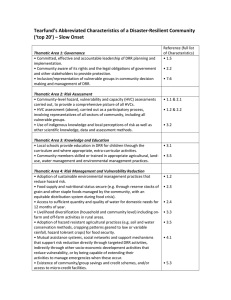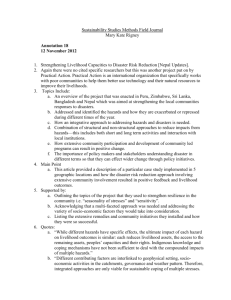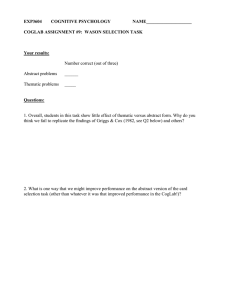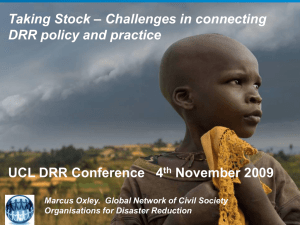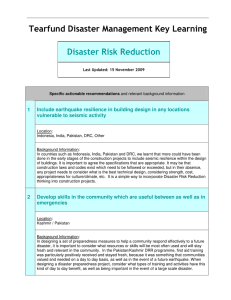Tearfund’s Abbreviated Characteristics of a Disaster-Resilient Community
advertisement
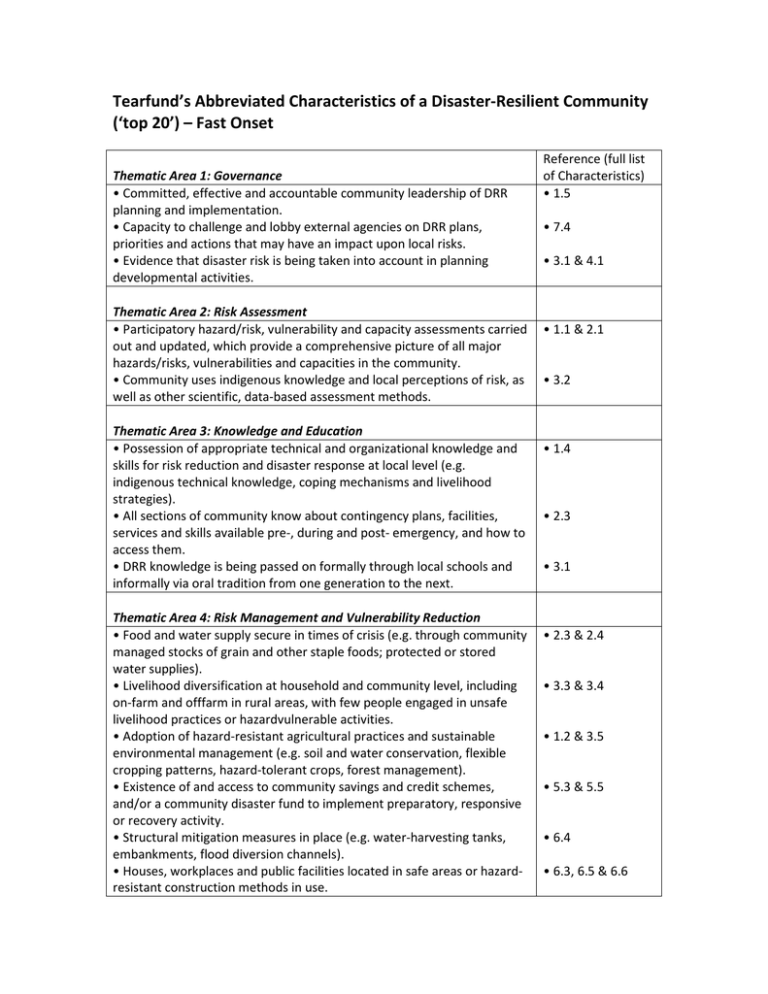
Tearfund’s Abbreviated Characteristics of a Disaster-Resilient Community (‘top 20’) – Fast Onset Thematic Area 1: Governance • Committed, effective and accountable community leadership of DRR planning and implementation. • Capacity to challenge and lobby external agencies on DRR plans, priorities and actions that may have an impact upon local risks. • Evidence that disaster risk is being taken into account in planning developmental activities. Thematic Area 2: Risk Assessment • Participatory hazard/risk, vulnerability and capacity assessments carried out and updated, which provide a comprehensive picture of all major hazards/risks, vulnerabilities and capacities in the community. • Community uses indigenous knowledge and local perceptions of risk, as well as other scientific, data-based assessment methods. Thematic Area 3: Knowledge and Education • Possession of appropriate technical and organizational knowledge and skills for risk reduction and disaster response at local level (e.g. indigenous technical knowledge, coping mechanisms and livelihood strategies). • All sections of community know about contingency plans, facilities, services and skills available pre-, during and post- emergency, and how to access them. • DRR knowledge is being passed on formally through local schools and informally via oral tradition from one generation to the next. Thematic Area 4: Risk Management and Vulnerability Reduction • Food and water supply secure in times of crisis (e.g. through community managed stocks of grain and other staple foods; protected or stored water supplies). • Livelihood diversification at household and community level, including on-farm and offfarm in rural areas, with few people engaged in unsafe livelihood practices or hazardvulnerable activities. • Adoption of hazard-resistant agricultural practices and sustainable environmental management (e.g. soil and water conservation, flexible cropping patterns, hazard-tolerant crops, forest management). • Existence of and access to community savings and credit schemes, and/or a community disaster fund to implement preparatory, responsive or recovery activity. • Structural mitigation measures in place (e.g. water-harvesting tanks, embankments, flood diversion channels). • Houses, workplaces and public facilities located in safe areas or hazardresistant construction methods in use. Reference (full list of Characteristics) • 1.5 • 7.4 • 3.1 & 4.1 • 1.1 & 2.1 • 3.2 • 1.4 • 2.3 • 3.1 • 2.3 & 2.4 • 3.3 & 3.4 • 1.2 & 3.5 • 5.3 & 5.5 • 6.4 • 6.3, 6.5 & 6.6 • Measures in place to protect key assets (e.g. livestock) and items of domestic property (e.g. use of raised internal platforms or plastic containers). Thematic Area 5: Disaster Preparedness and Response • Accessible emergency facilities and equipment available (for shelter, communications, rescue, etc.), owned and managed by the community. • Community-based and people-centred early warning system in place at local level, producing messages which are trusted and understood by whole community. • Community and family level contingency plans exist, developed and owned by the community, linked to higher-level plans and practised regularly. • Community has the capacity to provide effective and timely emergency response services, including training and deployment of volunteers with appropriate skills (e.g. search and rescue, first aid, managing emergency shelters, fire-fighting). • Community has appropriate plans and mutual support systems in place to take care of the most vulnerable – usually the elderly, disabled, AIDSsufferers, mothers and young children. • 6.8 • 1.6 • 2.1 & 2.3 • 3.2, 3.3 & 3.7 • 5.1 & 6.4 • 6.7
